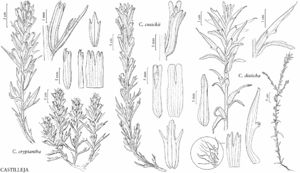Castilleja disticha
Proc. Calif. Acad. Sci., ser. 3, 2: 289. 1902. (as Castilleia)
Herbs, perennial, 1.4–8 dm; from a woody caudex; with a taproot. Stems many, erect, unbranched or branched, sometimes with small, leafy axillary branches, hairs spreading, long, soft, mixed with shorter stipitate-glandular ones. Leaves green or purple-tinged, lanceolate to linear-oblong, 0.8–6.1 cm, not fleshy, margins wavy, involute, 0(–3)-lobed, apex rounded to acute; lobes spreading-ascending, narrowly lanceolate, apex acute to acuminate. Inflorescences 3–34 × 1.5–3.5 cm; flowers usually distichous, remote, except distalmost; bracts proximally greenish, distally greenish, reddish, orange-red, or dull orange, rarely yellow, proximal bracts frequently greenish throughout, lanceolate to narrowly ovate or narrowly oblong-elliptic, 0(–3)-lobed, proximal wavy-margined; lobes ascending, triangular, short, arising near apex, apex acute to obtuse. Calyces proximally whitish, green, or purple, distally colored as bracts, 9–18 mm; abaxial clefts 6–6.5 mm, adaxial 7–9 mm, clefts 33+% of calyx length, deeper than laterals, lateral 1.5–4 mm, ca. 10% of calyx length; lobes linear-lanceolate, apex acute. Corollas ± curved, 25–38 mm; tube 14–18 mm; beak and often abaxial lip exserted; beak adaxially dull orange or dull red, rarely yellow, 14–19 mm; abaxial lip slightly curved, green, red, whitish, or yellow, not inflated, 2–2.5 mm, 15% as long as beak; teeth incurved, deep green to reddish, 1–1.5 mm. 2n = 24.
Phenology: Flowering (May–)Jun–Aug(–Sep).
Habitat: Open conifer forests, rocky or sandy slopes, montane to subalpine.
Elevation: 1600–3000 m.
Discussion
Castilleja disticha is limited to the central and southern Sierra Nevada. Although similar to C. applegatei and C. martini, C. disticha is distinctive and unique in its long, colorful, and highly exserted corollas with the beak exceeding the tube in length, calyces more brightly colored than the often unlobed bracts, and tall, strongly distichous growth form.
Selected References
None.
